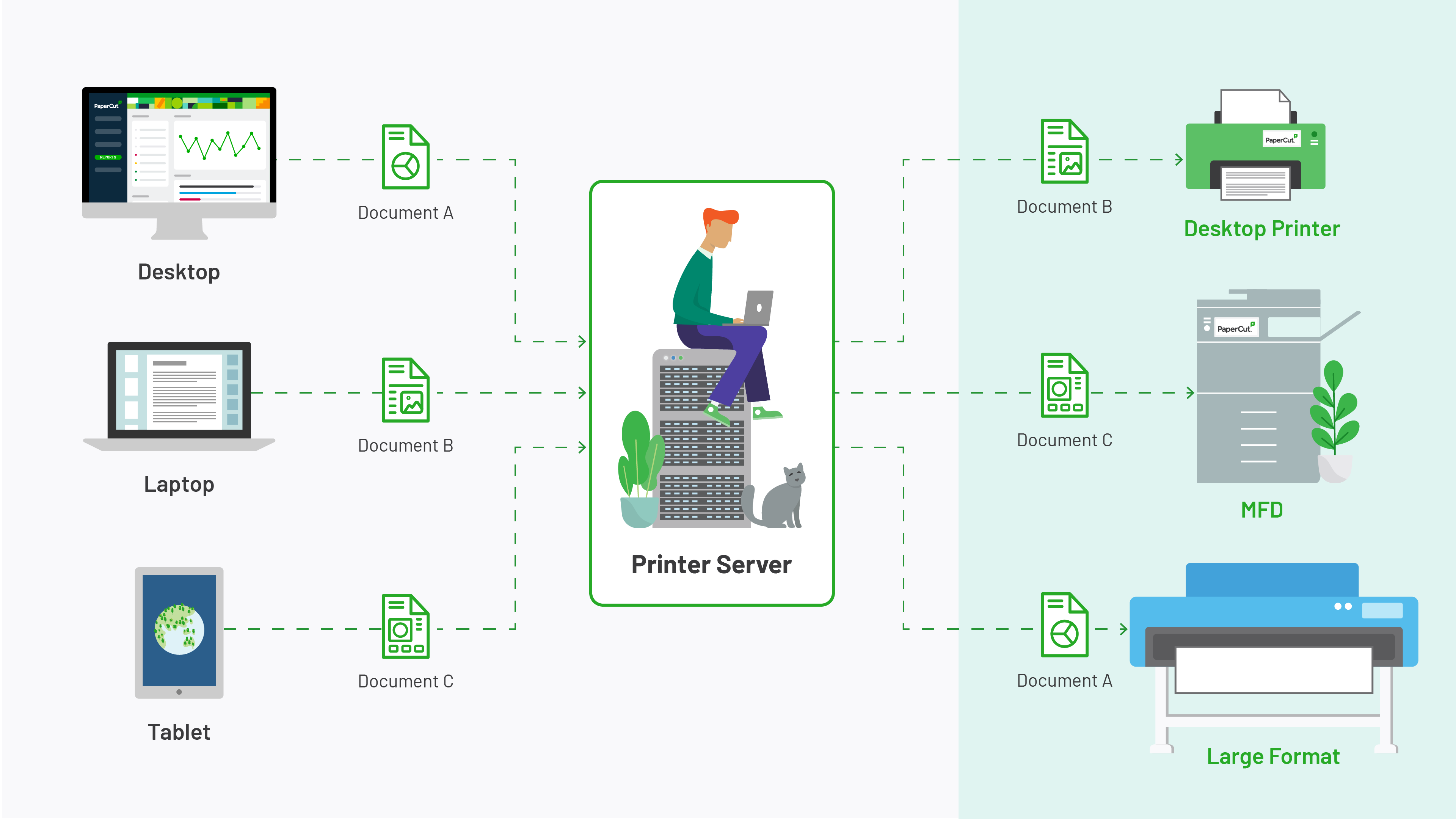Printing is more complicated than we realize. We expect to just press print, and then our job will instantly spit out at the printer. No mess, no fuss.
But there’s a bit more to it – printers aren’t computers. It’s mainly their job just to plop out the paper with the lines on it, so they need a bit of help on the computing side of things to process the print queues.
What is a print server?
A print server is either a software application, dedicated hardware device, or computer that manages and processes print requests within a network.
It functions by accepting print jobs from multiple users, queuing these jobs, and directing them to the appropriate printers.
Print servers facilitate the efficient handling of print requests, particularly in environments with high volumes or geographically dispersed printers.
They’re essential in both large organizations and small or home office settings, providing centralized management and control over printing resources.
Can’t you just print directly to the printer?
Totally. Direct IP printing is an alternative, where jobs are sent straight to the printer without a print server. But, this is part of the chaos.
Do sysadmins trust the end user to add a print driver that will talk the same language as the printer? Will your business record reams of paper loss as your accounting staff experiment with just the right print driver for the printer…
So, yeah, you can do it. But it’s not suitable for a workplace with multiple printers and dozens of users. It’s appropriate for a small number of users, or where a print server is not a justifiable expense.
However, it means there’s no tracking or reporting or overall print management available…
How does a print server work?
Print management software needs to live somewhere. For SMB’s right up to enterprises , a print server is recommended to host your print management solution.
Your print server can be a dedicated server just for your print system, or it can be an existing file or domain server (that’s a domain server, NOT a Domain Controller, they’re not appropriate as print servers).
Your print server operates in the background of your network, ushering jobs from the client to the printers. They primarily manage the print queue, as well as deploying print drivers to client machines.
- User presses print.
- The print server receives that request.
- The server then directs the print job to a printer.
- This places the job in a queue.
- When the job reaches the top of the queue, the printer prints the document.

Why do businesses need a print server?
Print servers make print management a breeze for workplaces with large device fleets and multiple offices.
A print server’s main task is to take care of the print queue. That’s the imaginary line where your print jobs wait after you press print.
Printers are different from computers and mobile devices. They’re peripheral to information technology but they themselves are actually mechanical devices with gears, ribbons, rollers, fusers, sensors, and cables.
There are a lot of moving parts in a printer. These extra mechanical components mean there’s more to maintain than your standard laptop or tablet.
Because of all that, printers have limited processing power and memory. The main reason for print servers is to have a central driver management experience and to configure queues and printer settings on one machine which will be distributed to all the clients.
Physical print servers are the most mature and powerful technology for managing printers. Like all things, there are advantages and disadvantages to having a print server.
Advantages of print servers
Dedicated powerful hardware
A print server literally has one job - to manage your print infrastructure. Their powerful processors exclusively look after your printers. This unlocks powerful printing speeds and High Availability for your workplace.
Takes care of all print complexity
Print servers can handle any number of workplace intricacies you throw at them. New users, permissions, policies, settings, etc. Whatever problem your print environment needs solving, your print server will tackle it.
Centralized management of print infrastructure
With a print server, print management becomes a singular beast. It allows your IT staff to control and manage printing from a centralized administration console.
Rather than having to manually check each device in your fleet. The print server centralizes access control for security purposes and also consolidates queue management so that sysadmins can view and manage all pending print jobs if need be.
Disadvantages of print servers
IT expertise required
A dedicated print server needs dedicated handlers. IT teams need to regularly maintain, update, and service a print server. They’re most suitable for workplaces with sysadmins (system administrators) on staff, or a third-party provider.
Single point of failure
As powerful and dependable as print servers are, they can be a bottleneck if there is a serious malfunction. If the server goes down, so does your printing. There are workarounds of course, but it is a consideration.
Do you need a print server?
For the modern workplace, something needs to manage your print fleet. The flexibility here is that print servers can either be hardware or a cloud service.
Print management is no longer only a print server game. There are many “serverless” print management solutions available. Something somewhere does the “server-ing” so to speak.
What kind of print management solution you need depends on your business’s printing demands. If you have a complex printing environment, i.e. dozens of devices, the size and scale of your workforce and printing may necessitate on-premises hardware.
In that case, your compliance and High Availability requirements are ideally served by a print server. However, if you’re a smaller business and you don’t have many servers, a “serverless” solution in the cloud is more suitable.
You won’t need to own or maintain a physical print server, you’ll just leverage a server in the cloud or use an alternative to the print server to do the print server’s job.
Print server alternatives
Direct printing
As mentioned above, workplaces with a small number of users can print directly to the printer with a Direct Printing solution. Jobs are controlled by the client/device/computer that pressed print.
Direct Printing is best suited for offices with a distributed workforce i.e. different offices and branches where end-users are local and not transient.
But even in this configuration, it’s best for a central headquarters to host a print server. However, it does mean each office/branch doesn’t need its own print server.
Find out more about our Direct Printing feature .
Serverless printing in the cloud
Like most technology these days, hardware isn’t your only option. You can manage print without a server and use a cloud print management solution instead. Cloud print management, also known as serverless printing, has different implementation types.
With a private cloud solution, your print server is hosted elsewhere and you access it over the internet. Or for a fully-hosted public cloud solution, a service in the cloud does the print server-ing for you.
Learn more about our cloud products PaperCut Hive and PaperCut Pocket for serverless printing options.




